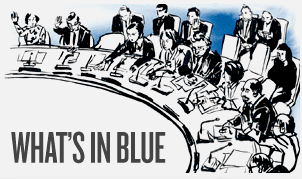Dispatches from Haiti Council Visit
Port-au-Prince: Since arriving in Haiti on 13 February, the Council mission has largely focused on the UN Stabilisation Mission in Haiti (MINUSTAH) and the implementation of its mandate. MINUSTAH was central to the Council delegation’s discussions with the Special Representative of the Secretary-General in Haiti, Mariano Fernández and Haitian Prime Minister Garry Conille. Highlights of Tuesday’s programme included meetings with President Michel Martelly and members of parliament as well as visits to a MINUSTAH police base and a Korean military engineering company. There was also a reception hosted by the Special Representative yesterday evening.
At the MINUSTAH base in Fort National in Port-au-Prince, Council members were given a briefing by the Force Commander, Major General Luiz Eduardo Ramos Pereira, on the implementation and impact of the Council-mandated drawdown of the mission.During the Council delegation’s visit to the base a group of demonstrators chanted anti-MINUSTAH slogans.
The Council delegation then took a helicopter to a MINUSTAH base in the town of Miragoâne, west of Port-au-Prince. The visit to Miragoâne focused on one of mission’s main tasks – building the capacity of the Haitian National Police (HNP) which will allow MINUSTAH to eventually drawdown. The Council delegation met with representatives both of MINUSTAH and the HNP as well as local officials. The Council delegation also met some formed police units that have recently replaced military personnel at the Miragoâne base. The UN police are now cooperating closely with the HNP. The key message conveyed to the Council delegation was that the shift from less military personnel and more police had been successful, with the local population responding positively to joint MINUSTAH/HNP patrols. The Council delegation also witnessed a joint MINUSTAH/HNP crowd control demonstration.
A second helicopter flight took the Council delegation to Léogâne, west of the capital, where a MINUSTAH engineering contingent from the Republic of Korea in constructing a new village for families displaced by the earthquake. (An important part of MINUSTAH’s mandate is to assist in earthquake reconstruction.)
It seems the Council delegation had a frank discussion with the presidents of both chambers of parliament and a group of senators. Among the areas covered was the difficult relationship between the legislative and executive branches, as the parliament is dominated by the opposition. It seems that the Haitian side also voiced concern about the way MINUSTAH had handled the accusations against it relating to the cholera outbreak and the allegations of sexual misconduct. However, it appears that they also emphasised the importance of not drawing the mission down too quickly.
The Council delegation’s meeting with President Martelly and some of his advisors lasted for over two hours. Apparently the discussion covered MINUSTAH’s role, evolution and eventual drawdown. It seems that Martelly also raised the government’s desire for a Haitian army, which would allow it to control the country’s borders (Haiti shares a land border with the Dominican Republic) and emphasised the importance of economic development for the country.
Today’s (15 February) programme will focus on economic development and reconstruction. The Council mission is scheduled to visit the city of Cap Haïtien in the north to discuss decentralisation with government and civil society representatives as well as city officials. There will also be visit to a tribunal and an industrial development site in Caracol as well as a police station in Port-au-Prince.
It seems that Council members have found it useful to get a “field” perspective on the MINUSTAH drawdown and the security situation. Council members are likely to be looking for evidence of whether a further drawdown of the mission later this year would be practical.
Some of the Council members also found it interesting to hear views on MINUSTAH from Haitian stakeholders. The meetings with Haitian political leaders appear to have offered a valuable insight into the positions of the different political actors in Haiti.

